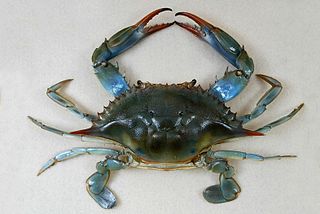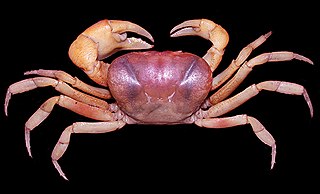
Sushi is a traditional Japanese dish made with vinegared rice, typically seasoned with sugar and salt, and combined with a variety of ingredients, such as seafood, vegetables, or meat: raw seafood is the most common, although some may be cooked. While sushi comes in numerous styles and presentation, the defining component is the vinegared rice, also known as shari (しゃり), or sumeshi (酢飯).

Mel Columcille Gerard Gibson is an American actor and filmmaker. The recipient of multiple accolades, he is known for his action hero roles, particularly his breakout role as Max Rockatansky in the first three films of the post-apocalyptic action series Mad Max and as Martin Riggs in the buddy cop action-comedy film series Lethal Weapon.

Hermit crabs are anomuran decapod crustaceans of the superfamily Paguroidea that have adapted to occupy empty scavenged mollusc shells to protect their fragile exoskeletons. There are over 800 species of hermit crab, most of which possess an asymmetric abdomen concealed by a snug-fitting shell. Hermit crabs' soft (non-calcified) abdominal exoskeleton means they must occupy shelter produced by other organisms or risk being defenseless.

Callinectes sapidus, the blue crab, Atlantic blue crab, or, regionally, the Maryland blue crab, is a species of crab native to the waters of the western Atlantic Ocean and the Gulf of Mexico, and introduced internationally.

Green papaya salad is a spicy salad made from shredded unripe papaya. It is generally believed to have been created by the Lao people and is considered one of the national dishes of Laos. Green papaya salad is also popular in neighbouring Thailand's Isan region, whose population is mainly composed of ethnic Lao and from where it spread to the rest of Thailand known as som tam. Green papaya salad has also spread to the rest of the continental Southeast Asia, as well as Xishuangbanna (China).

King crabs are decapod crustaceans of the family Lithodidae that are chiefly found in deep waters and are adapted to cold environments. They are composed of two subfamilies: Lithodinae, which tend to inhabit deep waters, are globally distributed, and comprise the majority of the family's species diversity; and Hapalogastrinae, which are endemic to the North Pacific and inhabit exclusively shallow waters. King crabs superficially resemble true crabs but are generally understood to be closest to the pagurid hermit crabs. This placement of king crabs among the hermit crabs is supported by several anatomical peculiarities which are present only in king crabs and hermit crabs, making them a prominent example of carcinisation among decapods. Several species of king crabs, especially in Alaskan and southern South American waters, are targeted by commercial fisheries and have been subject to overfishing.

Horseshoe crabs are arthropods of the family Limulidae and are the only surviving xiphosurans. Despite their name, they are not true crabs or even crustaceans. Rather, they are chelicerates. This makes them more closely related to arachnids like spiders, ticks, and scorpions. The body of a horseshoe crab is divided into three main parts: the cephalothorax, abdomen, and telson. The largest of these, the cephalothorax, houses most of the animal's eyes, limbs, and internal organs. It is also where the animal gets its name, as its shape somewhat resembles that of a horseshoe. Horseshoe crabs have changed little in appearance since they first evolved in the Triassic, earning them the title of "living fossil".
Florida State Prison (FSP), otherwise known as Raiford Prison, is a correctional institution located in unincorporated Bradford County, Florida, with a Raiford postal address. It was formerly known as the "Florida State Prison-East Unit" as it was originally part of Florida State Prison near Raiford. The facility, a part of the Florida Department of Corrections, is located on State Road 16 right across the border from Union County. The institution opened in 1961, even though construction was not completed until 1968. With a maximum population of over 1,400 inmates, FSP is one of the largest prisons in the state. FSP houses Florida's one of two male death row cell blocks and the State of Florida execution chamber. Union Correctional Institution also houses male death row inmates while Lowell Annex houses female death row inmates.

The Boston crab is a professional wrestling hold that typically starts with one wrestler lying in a supine position on the mat, with the other wrestler standing and facing them. It is a type of spinal lock where the wrestler hooks each of the opponent’s legs in one of their arms and then turns the opponent face-down, stepping over them in the process. The final position has the wrestler in a semi-sitting position and facing away from the opponent, with the opponent’s back and legs bent back toward their head. The original name for the maneuver was the Backbreaker, before that term became known for its current usage. In modern wrestling, the Boston crab is not treated as a lethal submission maneuver, even though it was considered a match-ending hold in the past.

Stunning is the process of rendering animals immobile or unconscious, with or without killing the animal, when or immediately prior to slaughtering them for food.

Jamar Shipman, better known by the ring name Jay Lethal, is an American professional wrestler. He is signed to All Elite Wrestling (AEW). He is best known for his tenures in Ring of Honor (ROH) and Total Nonstop Action Wrestling (TNA).

The Southern Maryland Blue Crabs are an American professional baseball team based in Waldorf, Maryland. They are members of the South Division of the Atlantic League of Professional Baseball, an independent "partner league" of Major League Baseball. Since 2008, the Blue Crabs have played their home games at Regency Furniture Stadium. They represent the counties of Charles, Calvert, and St. Mary's, which are located on the Southern Maryland peninsula between Chesapeake Bay and the Potomac River.

Parathelphusinae is a subfamily of freshwater crabs, which was formerly placed in the family Parathelphusidae; they are mainly found in South and Southeast Asia, but also found elsewhere in Asia and in Australia. The family is now considered as a junior synonym of the family Gecarcinucidae.

The Gecarcinucidae are a family of true freshwater crabs. They are found throughout South Asia, Southeast Asia and New Guinea, with a single genus found in Australia.

The coconut crab is a terrestrial species of giant hermit crab, and is also known as the robber crab or palm thief. It is the largest terrestrial arthropod known, with a weight of up to 4.1 kg (9 lb). The distance from the tip of one leg to the tip of another can be as wide as 1 m. It is found on islands across the Indian and Pacific Oceans, as far east as the Gambier Islands, Pitcairn Islands and Caroline Island and as far west as Zanzibar. While its range broadly shadows the distribution of the coconut palm, the coconut crab has been extirpated from most areas with a significant human population such as mainland Australia and Madagascar.

Zosimus aeneus, also known as the devil crab, toxic reef crab, and devil reef crab is a species of crab that lives on coral reefs in the Indo-Pacific from East Africa to Hawaii. It grows to a size of 60 mm × 90 mm and has distinctive patterns of brownish blotches on a paler background. It is potentially lethal due to the presence of the neurotoxins tetrodotoxin and saxitoxin in its flesh and shell.

Reston virus (RESTV) is one of six known viruses within the genus Ebolavirus. Reston virus causes Ebola virus disease in non-human primates; out of all 6 ebolaviruses, it is one of the only two not known to cause disease in humans, but has caused asymptomatic infections. Reston virus was first described in 1990 as a new "strain" of Ebola virus (EBOV). It is the single member of the species Reston ebolavirus, which is included into the genus Ebolavirus, family Filoviridae, order Mononegavirales. Reston virus is named after Reston, Virginia, US, where the virus was first discovered.

Esanthelphusa dugasti is a species of crab that belongs to the family Gecarcinucidae. Esanthelphusa dugasti lives in India, Myanmar, Cambodia, Laos, Vietnam, and Thailand. People in northern Thailand rely on Esanthelphusa dugasti as a source of protein.
Esanthelphusa nani is a species of crab of the family Gecarcinucidae. Esanthelphusa nani lives in rice paddy fields.















